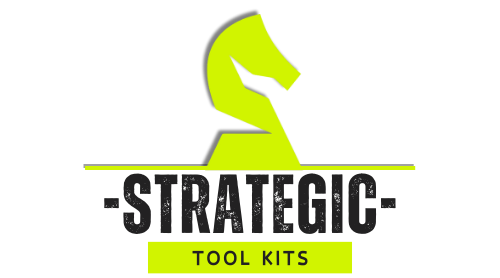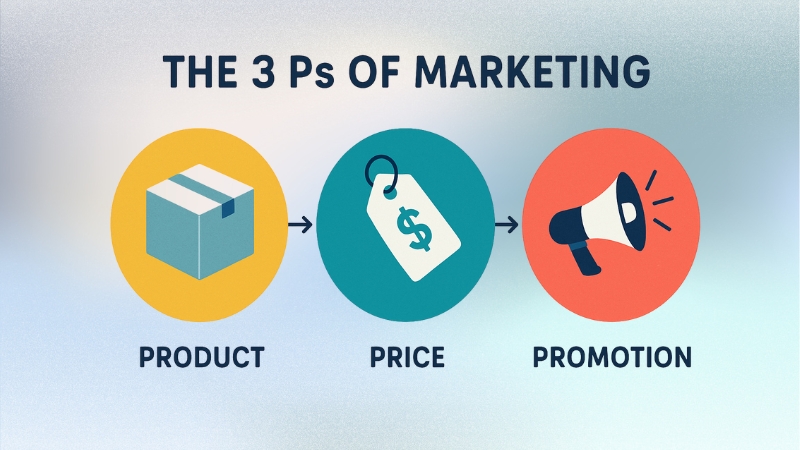The 3 Ps of Marketing – Product, Price, and Promotion – are core elements of any marketing strategy. They determine what you sell, how much you charge, and how you communicate your offer to the market. Together, they shape how a business attracts customers, differentiates itself from competitors, and achieves sales goals.
Unlike broader marketing models such as the 4 Ps or 7 Ps, the 3 Ps focus on the most immediate levers that impact consumer decision-making.
According to a 2025 HubSpot survey, over 60% of marketing professionals said that optimizing product-market fit, competitive pricing, and targeted promotion had the biggest direct impact on revenue growth.
This means that whether you’re launching a startup, repositioning an existing brand, or scaling internationally, mastering the 3 Ps is essential for consistent results.
1. Product – The Core Offering

Your product is not just a physical item – it’s the complete package of value you provide to the customer. This includes its features, design, quality, brand perception, and the problem it solves. In a competitive market, product decisions directly influence customer satisfaction and brand loyalty.
When defining your product, marketers analyze:
- Customer Needs & Pain Points – Identifying the problem the product solves.
- Unique Selling Proposition (USP) – How the product differs from competitors.
- Quality & Reliability – Meeting or exceeding market expectations.
- Brand Identity – The emotional and functional value attached to the product.
According to McKinsey research, successful product innovations can increase a company’s market share by up to 20% within two years if launched with proper market validation.
Aspect
Key Considerations
Example
Features
What functionalities solve customer problems?
A phone with AI-powered camera modes.
Design
Is it user-friendly and appealing?
Ergonomic, minimalist laptop design.
Quality
Does it meet durability and performance expectations?
Stainless steel water bottles with a lifetime warranty.
Brand Perception
Does it align with customer values?
Eco-friendly packaging for sustainability-minded buyers.
2. Price – Positioning Through Value
View this post on Instagram
Price is the amount customers are willing to pay for your product, reflecting both its perceived and actual value. Pricing strategy affects profitability, market positioning, and even brand perception.
A low price can attract volume but may reduce margins; a premium price can enhance brand prestige but risks limiting your customer base.
Pricing decisions often depend on:
- Cost Structure – Covering production, marketing, and distribution costs.
- Market Demand – What customers are prepared to pay.
- Competitor Pricing – Staying competitive while maintaining profitability.
- Perceived Value – Justifying price through quality, features, or exclusivity.
Statista data (2024) shows that pricing optimization can improve margins by 2–7% on average, with a significant impact on industries with high competition, such as consumer electronics and retail.
Pricing Model
Description
When to Use
Example
Penetration
Low initial price to gain market share.
New market entry.
Streaming service offering $1/month promo.
Skimming
High initial price, lowered over time.
Innovative products.
Flagship smartphones.
Value-Based
Price based on perceived customer value.
Premium brands.
Luxury watches.
Competitive
Match or beat the market average.
Saturated markets.
Grocery store pricing on staples.
3. Promotion – Communicating Value

Promotion refers to the activities used to inform, persuade, and remind customers about your product. This includes advertising, sales promotions, content marketing, public relations, events, and social media campaigns.
Effective promotion requires:
- Target Audience Clarity – Knowing who you are speaking to.
- Channel Selection – Choosing the most effective media (digital, print, TV, in-person).
- Message Consistency – Keeping the brand tone and value proposition aligned.
- Performance Tracking – Measuring ROI on campaigns and adjusting as needed.
According to the Content Marketing Institute, brands that align promotion channels with their target audience behavior see up to 3x higher engagement rates than those that rely on generic campaigns.
Channel Type
Strengths
Best For
Example
Digital Ads
High reach, measurable ROI.
E-commerce, tech products.
Google Ads, Facebook Ads.
Influencer Marketing
Builds trust via third-party credibility.
Lifestyle brands, cosmetics.
Instagram product reviews.
Email Marketing
Direct and personalized communication.
Repeat customer engagement.
Loyalty program offers.
PR & Events
Strong credibility, community impact.
Local businesses, NGOs.
Charity sponsorships.
How the 3 Ps Work Together
While each P can be optimized individually, its real power lies in integration.
For example, a premium product (Product) requires a price point (Price) that matches its value perception, along with a promotional strategy (Promotion) that targets the right audience in the right tone. Misalignment – such as luxury pricing with low-budget promotion – creates confusion and reduces sales potential.
Adapting the 3 Ps for Digital Marketing Channels
The shift from traditional marketing to digital platforms has fundamentally changed how the 3 Ps are executed. While the principles remain the same, the tactics, tools, and speed of execution are very different online.
For Product, digital channels require not just a great product but also a digital presentation – high-quality images, videos, and interactive product demos.
In e-commerce, customers cannot physically touch or test an item, so the online representation must communicate quality, functionality, and brand personality instantly.
Price in digital environments is more transparent. Customers can compare prices within seconds across multiple retailers. This has made dynamic pricing – adjusting prices based on demand, competition, and customer behavior – more common.
According to a 2023 Deloitte study, 46% of online retailers use AI-based dynamic pricing tools to stay competitive in real time.
For Promotion, the digital landscape offers precise targeting through channels like paid social, search ads, influencer partnerships, and email automation. Unlike traditional mass media, online campaigns can be optimized daily or even hourly based on click-through rates and conversions.
This means marketers can refine messages much faster and with far more data-backed insight.
P Element
Digital Adjustment
Example
Product
Interactive demos, user-generated reviews, 3D models
Furniture store offering an AR “see in your room” feature
Price
Dynamic adjustments, personalized discounts
Airline ticket pricing that changes based on demand
Promotion
Targeted ads, influencer content, retargeting
Fashion brand running TikTok influencer campaigns
Common Mistakes Businesses Make with the 3 Ps

Even experienced marketers can make strategic errors when implementing the 3 Ps, often because of misalignment between them or a lack of market data.
One common mistake is launching a Product without proper market research, assuming that quality alone will guarantee success. Without understanding customer needs, even a technically superior product can fail.
With Price, a frequent misstep is setting prices based on costs alone, ignoring perceived value and competitive positioning. For example, underpricing a premium product can harm brand perception, while overpricing without justification can deter sales.
In Promotion, the biggest pitfall is targeting the wrong audience or using channels that don’t align with customer behavior.
According to HubSpot’s 2024 State of Marketing report, 39% of marketers admit they have wasted budget on channels that didn’t reach their intended audience.
P Element
Mistake
Impact
Product
Ignoring customer feedback in development
Low adoption rates
Price
Setting price without considering perceived value
Poor conversion despite good traffic
Promotion
Using generic campaigns without audience segmentation
Low engagement, wasted budget
Measuring Success Across the 3 Ps
Tracking performance is critical to knowing whether your Product, Price, and Promotion strategies are working. Without data, it’s impossible to refine your approach or justify marketing spend.
For Product, key metrics include return rates, customer satisfaction scores (CSAT), and product reviews. These indicate whether the product meets or exceeds customer expectations. In digital markets, average star rating and review volume can heavily influence purchase decisions.
Studies show that products with a 4-star rating or higher convert up to 3.5 times better than lower-rated items (Spiegel Research Center, 2023).
In Price, metrics like price elasticity, conversion rate by price point, and average order value (AOV) reveal how pricing changes impact sales. Monitoring competitor pricing tools can also help you see if your price remains competitive.
For Promotion, measure return on ad spend (ROAS), click-through rate (CTR), cost per acquisition (CPA), and customer lifetime value (CLV). Tracking these over time allows marketers to allocate budgets to the most effective campaigns.
@digitalgrowthwitherfan Customer Lifetime Value ! WHAT IS IT 🚨🚨🚨#marketing #digitalmarketing #adwords #businesstips ♬ original sound – Digital Growth With Erfan
P Element
Key KPIs
Why It Matters
Product
CSAT, return rate, star rating
Shows product-market fit and customer satisfaction
Price
Conversion rate by price, AOV, elasticity
Helps identify the optimal price for revenue and profit
Promotion
ROAS, CTR, CPA, CLV
Determines campaign efficiency and long-term value
Bottom Line
The 3 Ps of Marketing – Product, Price, and Promotion- remain as relevant today as when they were first introduced, but the methods for executing them have evolved with technology and consumer behavior.
Businesses that understand and align these three elements can more effectively meet customer needs, strengthen their market position, and improve profitability. Whether you’re a startup testing your first launch or an established company refining your market approach, these fundamentals provide a proven framework for driving growth.

